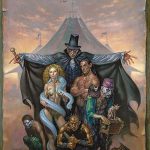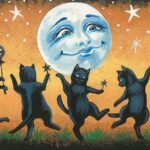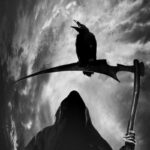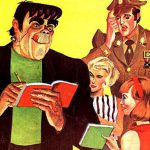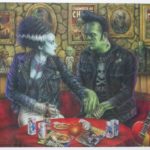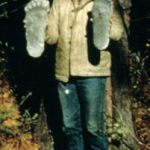History of malevolent clowns
Clowns have appeared in most cultures since the beginning of recorded history. The earliest documented clowns go back to ancient Egypt, some time around 2500 to 2400 BCE. In ancient imperial China, a court clown called YuSze was, according to the lore, the only guy who could poke holes in Emperor Qin Shih Huang’s plan to paint the Great Wall of China. Hopi Native Americans had a tradition of clown-like characters who interrupted serious dance rituals with ludicrous antics. Clowns were also around in ancient Greek and Roman societies. These clowns would eventually turn into the court jesters of medieval Europe, who “would openly mock sex, food, drink, and the monarchy, all while behaving maniacally for a laugh.
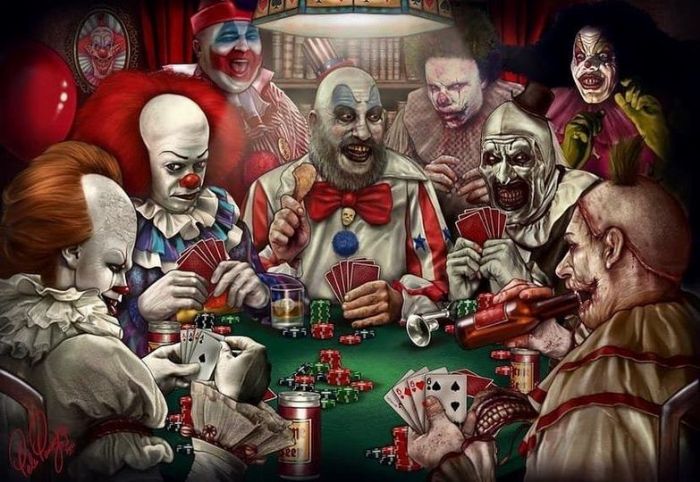
According to Andrew McConnell Stott, Dean of Undergraduate Education and English professor at the University of Buffalo, SUNY,
“The medieval fool was continually reminding us of our mortality, our animal nature, of how unreasonable and petty we can be.” He also speaks on the jesters of Shakespeare, saying of them that they “were often linked to death and dark truths. King Lear’s fool wanders around reminding everyone that they’re not as clever as they think they are while talking in contorted double speak to undermine our sense of what we think is going on.”
Steven Schlozman, a Harvard Medical School psychiatrist, also wrote, alluding to Victor Hugo’s ‘The Man Who Laughs‘:
“Clowns in the Middle Ages, if they didn’t make the king laugh, they paid a pretty steep price. A lot of the jesters were mutilated to make them smile all the time. They would have the muscles cut that enabled the mouth to frown.”
It wasn’t until the 19th century that clowns started getting a bad reputation—Edgar Allen Poe’s 1849 short story “Hop-Frog” featured a court jester out for revenge, and the 1892 opera Pagliacci features a murderous clown.
The modern idea of the circus clown is attributed to Joseph Grimaldi, a British actor and pantomimist who lived from 1778 to 1837. Grimaldi created the classic image of a clown, with white face makeup and colorful hair, and used a lot of physical comedy in his act. However, outside of his act, Grimaldi’s life was a series of hardships. He suffered from depression, his first wife died in childbirth, and his son, who was also a clown, died of alcoholism at the age of 31. In addition, Grimaldi’s slapstick routines had left him disabled and permanently in pain. He once famously said, “I am grim all day, but I make you laugh at night.”
After his death, Grimaldi’s memoirs were edited by Charles Dickens. Dickens put his own spin on the lives of Grimaldi and his son, and his version of the account became popular. Andrew Stott claims that Dickens’ take on the Grimaldis was the beginning of the idea of the scary clown.
By the late 1800s, clowns had become a staple in circuses. French literary critic Edmond de Congourt said of them in 1876,
“The clown’s art is now rather terrifying and full of anxiety and apprehension, their suicidal feats, their monstrous gesticulations and frenzied mimicry remind one of the courtyard of a lunatic asylum.”
Bozo the Clown started appearing on local television in Los Angeles in 1949. In the late ’50s, he was franchised, which meant that local TV stations around the country each had their own shows starring their own versions of Bozo, making the clown both extremely popular and omnipresent. In the early 1960s, Washington-area McDonald’s saw sales spike 30 percent after a local franchise sponsored the TV show Bozo’s Circus. In 1963, that franchise hired the guy who had played Bozo—who happened to be Willard Scott, the future Today show weatherman—to appear on some local TV stations as a new character, Ronald McDonald.
In 1966, Ronald McDonald—with his red hair, yellow-and-red jumpsuit, and starry eyes—went national, in the first national ad campaign for a fast-food chain. He was so successful that by the 1990s, Ronald McDonald was recognizable to 96 percent of American children, bested only by Santa Claus.
The modern notion of the evil clown came to real life in the 1970s with the serial killer John Wayne Gacy, who notoriously was also a registered clown by the name of Pogo. He was nicknamed the “Killer Clown” though he didn’t actually commit his crimes while wearing his clown costume. He embraced the nickname, and while in prison he painted many pictures of clowns, including some self-portraits of him dressed as Pogo. Gacy famously said, “You know . . . clowns can get away with murder.”
Stanley Kubrick’s dystopian crime film A Clockwork Orange (1971) and Stephen King’s 1986 horror classic It (1986) capitalized on Westerners newfound fear. While Kubrick’s clown is merely a normal person that acts frenzy, It is a pan-dimensional monster which feeds mainly on children by luring them in the form of a clown, named “Pennywise.
Most evil clowns in fiction are either completely psychotic homicidal maniacs, or particularly malevolent tricksters and pranksters. Often, they are both. Evil Clowns are also invariably portrayed as being sadistic and many are also emphasized as not even being human but rather some kind of Lovecraftian horror (Killer Klowns From Outer Space).
Batman villain the Joker and American Horror Story: Freak Show, along with a recent movie version of It keep evil clowns fresh in our minds. In American Horror Story‘s case, the portrayal of the murderous clown Twisty was evidently so offensive that it sparked outrage from Clowns of America International.
The fear of clowns
The concept of the evil clown is related to the irrational fear of clowns, known as coulrophobia, a neologism coined in the context of informal “-phobia lists”.
Many theories point to the fear of clowns being linked directly to their face makeup. Wolfgang M. Zucker, author of the article “The Image of the Clown,” pointed out that there are similarities between the appearance of clowns and cultural depictions of demons. Andrew Stott (Clowns on the Verge of a Nervous Breakdown) also has opinions on the subject of clown faces. He has said, “Where there is mystery, it’s supposed to be evil, so we think, ‘What are you hiding?'”
In 2008, a widely reported University of Sheffield, England, survey of 250 children between the ages of four and 16 found that most of the children disliked and even feared images of clowns. The BBC’s report on the study featured a child psychologist who broadly declared, “Very few children like clowns. They are unfamiliar and come from a different era. They don’t look funny, they just look odd.”
Stott believes that the clown has been “evacuated as a figure of fun”; psychologists suggest that negative clown images are replacing positive clown images.
“You don’t really see clowns in those kinds of safe, fun contexts anymore. You see them in movies and they’re scary. Kids are not exposed to that kind of safe, fun context as much as they used to be and the images in the media, the negative images, are still there.”
says Dr. Martin Antony, a professor of psychology at Ryerson University in Toronto and author of the Anti-Anxiety Work Book.
It has been found that adults who are scared of clowns find the inability to read emotions through the clown makeup unsettling. Dr. Ronald Doctor, a professor of psychology at California State University, says, “Kids around two or so are very reactive to a familiar body type with an unfamiliar face. This early negative response to a clown can lead to a lifelong fear through to adulthood.” Adult clown phobics are unsettled by the clown’s face-paint and the inability to read genuine emotion on a clown’s face, as well as the perception that clowns are able to engage in manic behavior, often without consequences.
Clowns also may fall under the uncanny valley effect. Steven Schlozman says, “The uncanny explains a lot of horror tropes, where you look at something and it’s not quite right – like a human face that’s decomposing. It’s recognizable, but just enough away from normal to scare you.” British horror writer Ramsey Campbell has said, “It is the fear of the mask, the fact that it doesn’t change and is relentlessly comical.”
Famous evil clowns in fiction
- The Joker character in the Batman franchise was introduced in 1940
- Pennywise the Dancing Clown, the main antagonist in Stephen King’s 1986 horror novel It and its adaptations. Pennywise was portrayed in the 1990 television miniseries version by Tim Curry and by Bill Skarsgård in the 2017 film adaptation and its 2019 sequel.
- Ronald McDonald – most parodies of Ronald show him as a monster rather than for laughs.
- The 1988 film Killer Klowns from Outer Space, directed by the Chiodo Brothers, features extraterrestrial evil clowns as the story’s antagonists.
- Sweet Tooth – Insane Psycho clown Killer from the Twisted Metal video game series.
- Madkat, a spirit of a mad jester possessing an equally mad stand-up comedian in Swat Kats.
- Scooby-Doo’s Ghost Clown from the episode Bedlam in the Big Top
- Violator, a supervillain demon appearing in the Spawn comic books published by Image Comics, is commonly depicted in the form of “Clown”, a balding, overweight man with blue facepaint.
- Horny the Clown in the 2007 horror-comedy movie Drive-Thru
- Krusty the Clown, a cartoon character introduced in 1989 in the animated sitcom The Simpsons
- The 2014 film Theatre of Fear, directed by Andrew Jones, featured a murderous clown character played by Nathan Head.
- The 1982 film Poltergeist, directed by Tobe Hooper and produced by Steven Spielberg, along with the 2015 remake of the same name directed by Gil Kenan, feature a possessed clown doll
- The American rap duo Insane Clown Posse
- The 1989 film Clownhouse, written and directed by Victor Salva, concerns brothers who are attacked in their own home by escaped mental patients dressed as clowns.
- Jack the Clown, an icon of the Halloween Horror Nights event celebrated at Universal Studios Florida, Universal Studios Hollywood, Universal Studios Singapore, and Universal Studios Japan.
- Captain Spaulding, a vulgar clown and serial killer portrayed by Sid Haig in the 2003 Rob Zombie film House of 1000 Corpses and its 2005 sequel The Devil’s Rejects.
- Jigsaw in the Saw horror movie franchise.
- The 2012 film Stitches features a murderous birthday clown, portrayed by Ross Noble, who is resurrected from the dead in order to enact revenge upon the children who contributed to his death.
- The 2013 horror film All Hallows’ Eve and the 2018 film Terrifier features a homicidal clown named Art the Clown.
- The FX horror anthology series American Horror Story used two instances of evil clowns: The first being Twisty the Clown from the fourth season Freak Show, who made a cameo appearance in Cult where the season’s antagonist created a murderous clown cult to orchestrate his rise to political power.
- The 2014 horror film Clown, directed by Jon Watts and produced by Eli Roth, follows a man who, upon finding and wearing a clown suit, becomes trapped in the cursed skin of an ancient Nordic demon known as the Clöyne.
- The film Balada Triste de Trompeta aka The Last Circus (2010, Álex de la Iglesia) follows a circus troupe through the Spanish Civil War as they are forced to fight, confront the darkest sides of human nature and face the dark inside themselves.
- The 2017 film Behind the Sightings was inspired by the viral clown sightings of 2016.


